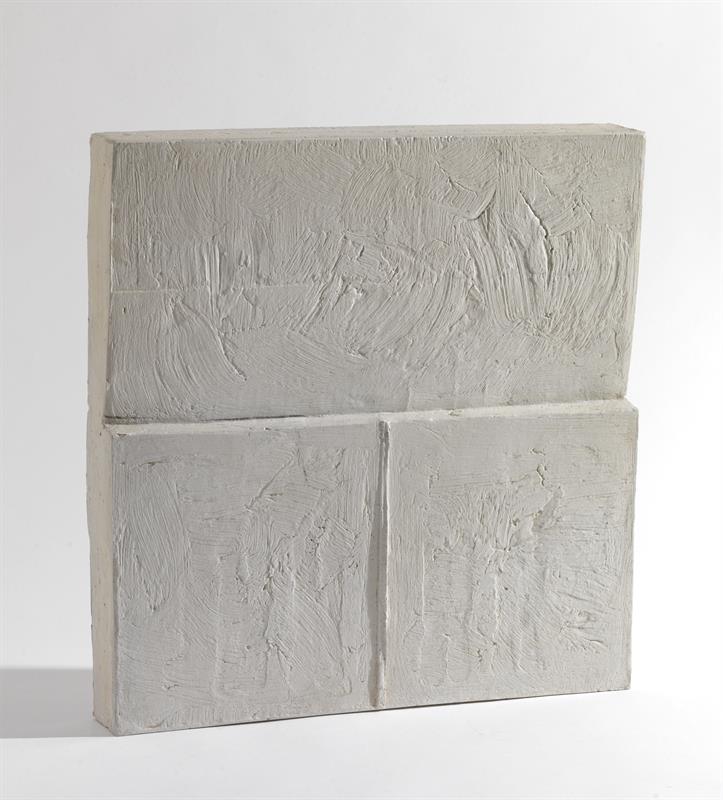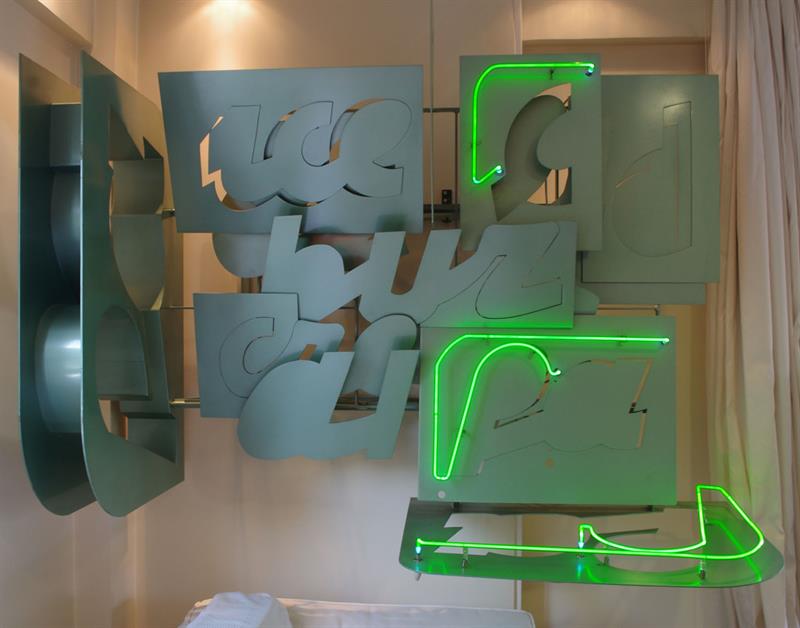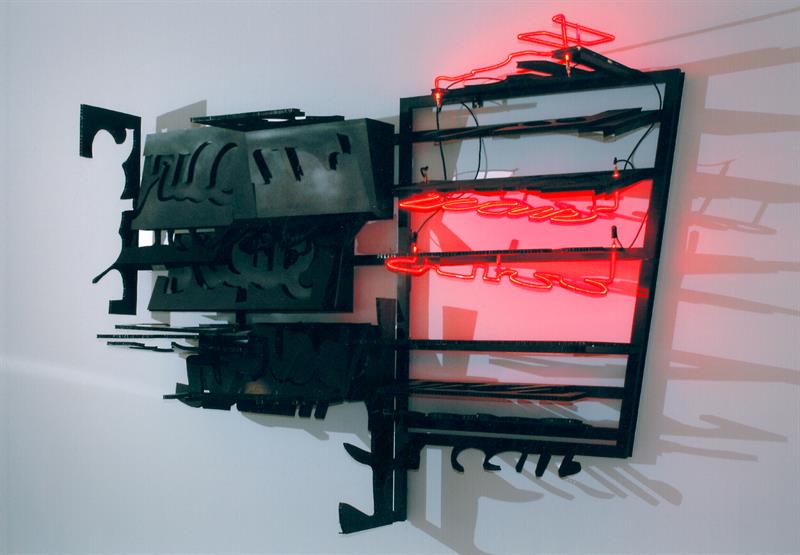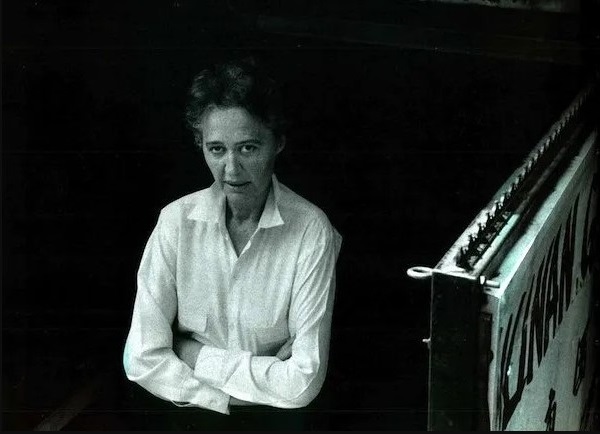Chryssa was born in 1933 in Athens. She studied in Paris (Academie de la Grande Chaumière, 1953-1954) and in San Francisco (California School of Fine Arts, 1954-1955). From 1955 she settled permanently in New York. There she had her first solo exhibition (1961, Betty Parsons) and the same year she exhibited at the Guggenheim Museum. Her work was soon recognized and joined the American artistic reality, among the renewal proposals that succeeded abstract expressionism.
She draws her inspiration from images and phenomena of modern life in big cities, with a particular emphasis on the signs and symbols that dominate the written word of mass communication, in printed matter and inscriptions. The purely visual treatment of linguistic symbols was already evident in her early works (painting, relief or three-dimensional), such as the section entitled Cycladic Books (1957-1962). During the 1960s, the best-known feature of her work developed, the use of neon light tubes in various shapes and colors, a clear reference to the glow of billboards (The Gates of Times Square, 1964-1966).
In her sculptures, which are often of large dimensions, she uses various construction methods and materials (aluminum, steel, plexiglass, neon and others). Despite their technological nature, they highlight the subtle nuances of a completely personal sensibility. The sculptor’s vision is expressed through the play with light, the harmonious organization of the compositions, the emblematic ideograms and the subtle references to Greek antiquity, Byzantium or the female body.
At the beginning of the 1990s she worked for a while in Greece, where she created a series of works (Cinema Oasis), using the hall of an old cinema as a laboratory. Since 2007 she lives permanently in Athens.
She has had numerous solo exhibitions in the US and Europe, in important galleries and major museums. She participated in group and international events, such as the Biennale of Sao Paulo (1963 and 1969) and Venice (1972) and Documenta 4 (1977, Kassel, Germany). In Greece, she presented her first solo exhibition in 1979 at the Zoumboulakis gallery, while in 1980 a retrospective exhibition was organized at the National Gallery.
Many of her works adorn public spaces in different parts of the world. The best known in Athens are Klytemnestra (1967) outside the Athens Concert Hall and Mott Street, which was installed in 2004 at the Evangelismos station of the Athens Metro.
She died in Athens on December 23, 2013.
Η Χρύσα Βαρδέα-Μαυρομιχάλη (Chryssa) γεννήθηκε το 1933 στην Αθήνα. Σπούδασε στο Παρίσι (Academie de la Grande Chaumière, 1953-1954) και στo Σαν Φρανσίσκο (California School of Fine Arts, 1954-1955). Από το 1955 εγκαταστάθηκε μόνιμα στη Νέα Υόρκη. Εκεί έκανε την πρώτη της ατομική έκθεση (1961, Betty Parsons) και την ίδια χρονιά εξέθεσε στο Guggenheim Museum. Το έργο της σύντομα αναγνωρίστηκε και εντάχθηκε στην αμερικανική καλλιτεχνική πραγματικότητα, μεταξύ των ανανεωτικών προτάσεων που διαδέχθηκαν τον αφηρημένο εξπρεσιονισμό.
Αντλεί την έμπνευσή της από εικόνες και φαινόμενα της σύγχρονης ζωής των μεγαλουπόλεων, με ιδιαίτερη έμφαση στα σημεία και σύμβολα που κυριαρχούν στο γραπτό λόγο της μαζικής επικοινωνίας, σε έντυπα και επιγραφές. Η καθαρώς εικαστική αντιμετώπιση των γλωσσικών συμβόλων ήταν ήδη φανερή στα πρώιμα έργα της (ζωγραφικά, ανάγλυφα ή τρισδιάστατα), όπως η ενότητα με τίτλο Κυκλαδικά Βιβλία (1957-1962). Μέσα στη δεκαετία του 1960 αναπτύχθηκε το γνωστότερο χαρακτηριστικό της δουλειάς της, η χρήση των φωτεινών σωλήνων με νέον σε διάφορα σχήματα και χρώματα, μια σαφής παραπομπή στη λάμψη των διαφημιστικών πινακίδων (Οι Πύλες της Times Square, 1964-1966).
Στα γλυπτά της, που συχνά είναι μεγάλων διαστάσεων, χρησιμοποιεί διάφορες κατασκευαστικές μεθόδους και υλικά (αλουμίνιο, ατσάλι, πλεξιγκλάς, νέον και άλλα). Παρά τον τεχνολογικό τους χαρακτήρα, αναδεικνύουν τις λεπτές αποχρώσεις μιας εντελώς προσωπικής ευαισθησίας. Το όραμα της γλύπτριας εκφράζεται μέσα από το παιχνίδι με το φως, την αρμονική οργάνωση των συνθέσεων, τα εμβληματικά ιδεογράμματα και τις διακριτικές αναφορές στην ελληνική αρχαιότητα, στο Βυζάντιο ή στη γυναικεία υπόσταση.
Στις αρχές της δεκαετίας του 1990 εργάστηκε για ένα διάστημα στην Ελλάδα, όπου δημιούργησε σειρά έργων (Cinema Oasis), χρησιμοποιώντας ως εργαστήριο την αίθουσα ενός παλιού κινηματογράφου. Από το 2007 ζει μόνιμα στην Αθήνα.
Έχει κάνει πολυάριθμες ατομικές εκθέσεις στην Αμερική και στην Ευρώπη, σε σημαντικές γκαλερί και μεγάλα μουσεία. Συμμετείχε σε ομαδικές και διεθνείς διοργανώσεις, όπως στις Μπιενάλε του Sao Paulo (1963 και 1969) και της Βενετίας (1972) και στη Documenta 4 (1977, Kassel, Γερμανία). Στην Ελλάδα παρουσίασε την πρώτη της ατομική το 1979 στη γκαλερί Ζουμπουλάκη, ενώ το 1980 οργανώθηκε αναδρομική της έκθεση στην Εθνική Πινακοθήκη.
Πολλά έργα της κοσμούν δημόσιους χώρους σε διάφορα μέρη του κόσμου. Τα γνωστότερα στην Αθήνα είναι η Κλυταιμνήστρα (του 1967) έξω από το Μέγαρο Μουσικής Αθηνών και η Mott Street, που τοποθετήθηκε το 2004 στον σταθμό Ευαγγελισμός του αθηναϊκού Μετρό.
Πέθανε στην Αθήνα στις 23 Δεκεμβρίου 2013.
Biography Source | Πηγή Βιογραφικού: http://dp.iset.gr/artist/view.html?id=521
View works of Chryssa on Art.gr | Εργα της Χρύσα Βαρδέα-Μαυρομιχάλη στο Art.gr








